As the sixth generation gets acquainted with the cattle-raising way of life at Trowbridge Farms in Ghent, New York, grandparents Phil and Annie Trowbridge and son P.J. are keeping an eye on the future.
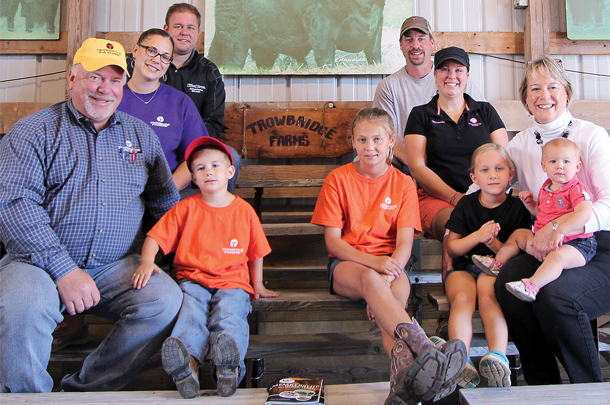
Like the old cowboy adage, they “ride for the brand” – at the nexus with consumers nestled just 120 miles upstate from New York City in the rolling foothills of the Catskills Mountain Range.
On Sept. 29, Trowbridge Farms received, in San Antonio, Texas, the first-ever Certified Angus Beef (CAB) ambassador award for their willingness to put themselves – and their cattle – on display with consumers at the farm, in grocery store parking lots, county fairs, impromptu visits by schools, dieticians, chefs, reporters – you name it.
Phil’s willingness to be a sounding board for young producers and bring to consumers the positive, and realistic, message about beef production crosses all breeds and management styles.
New York state is home to more than 13,500 cattle operations and 1.45 million cattle. While Angus is the dominant breed in the Northeast today, Herefords run second, and the region’s beef production includes many commercial cow-calf and backgrounding operations as well as farm-feedlots.
“I enjoy everything about this business. It’s the cattle but even more so the people – and these kids, I just love watching them come along,” says Phil with a smile, holding toddler Lily on his lap during much of the interview and pausing to discuss what to feed the heifers with 10-year-old Daisy, who hops on the Gator with Chelsea Dodge, the 119th college intern to work here on the farm.
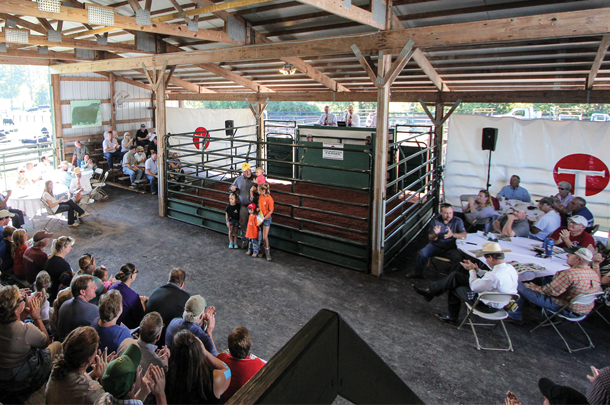
Coming from a large family of farmers in western New York state, there was no passing of a farming operation to Phil. Like many next-generation farmers, Phil struck out on his own after graduating from Alfred State in 1976.
He followed his passion working in the industry he loved, all the while saving money for the day he and Annie would buy a farm of their own.
The love of Angus began years earlier when Phil’s grandfather purchased the first Angus as 4-H project for Phil’s oldest brother.
Today’s pride and passion are wrapped up in the families – two-legged and four-legged. Some of the better cow families have been going strong here for 30 to 35 years and have produced nearly 100 bulls that have gone on to all the major A.I. studs. One of the best they’ve bred was Travelor004.
“Annie and I brought Trowbridge Angus to this area in 1977 with our own first cow purchase that year. This is what we’ve built,” Phil relates during an interview on the day prior to their annual female sale that drew hundreds to the farm on a clear, warm day in late September.
Buyers from more than a dozen states bid in person and via the Internet, with some sales going as far west as Montana and as far south as Georgia. Others went to new homes just over the hill. Managed by the American Angus Association and promoted by Mike Shanahan, the sale totaled 102 lots – some cows, some pairs with calves at side, some bred heifers and even embryos.
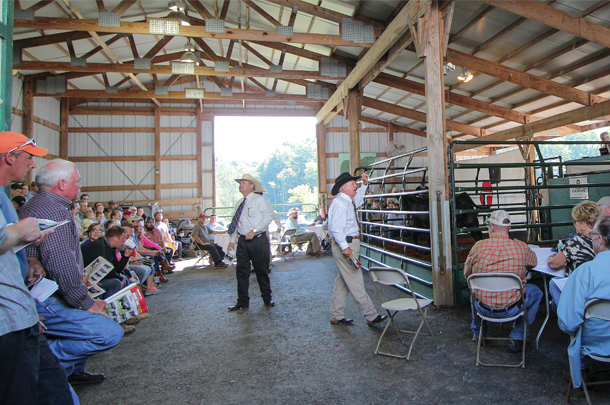
Whole lots averaged $6,105 with the first sale of the day, an Insight daughter of Pure Pride born in January, bringing the day’s top price of $20,000.
Some of the cattle were consigned by other farms in the area that have purchased genetics from the family’s spring bull sale, held annually the past 16 years at the auction market in Canandaigua. The offering of 62 bulls last May averaged $4,800.
A cowman and people person, Phil visits customers and works with them to sell their animals. In fact, the “family affair” theme of the fall female sale is not only a reference to the deep cow families here but also the co-marketing he does with customers.
Not only can they consign females in September, Trowbridge Farms hosts a customer feeder calf sale the first Saturday in December each year in Canandaigua. Last year’s sale attracted 300 head.
Preparation for sale starts a year in advance. They pick the top end of the first-bred older heifers and calves because they get a better idea how they are growing and what they will look like next fall. By targeting the animals early, they can talk about them all year.
“We’ve worked hard to identify good cow families and build on them. We have many generations from some of these cows,” Phil explains. The Trowbridge Pure Pride family, for example, traces back to a cow from Massachusetts with a genetic line straight back to the origin of the Angus breed in Scotland.
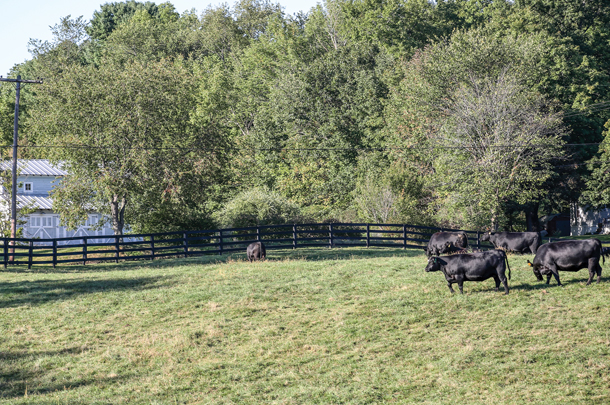
He believes the cow side of an animal’s pedigree is most telling to make the bulls from the herd what they are in transmitting genetics to offspring.
Today’s genetic advances are propelled by genomics, Phil observes: “In today’s world, if you are not studying genomics, you are on the outside looking in, but phenotype is still very important to us. We don’t do single-trait selection.
That’s a recipe for disaster. I would love to have cattle that are in the top 1 percent for everything, but that isn’t practical. We take a balanced approach.”

Phil likes to see cattle that are phenotypically balanced from end to end. “I start from the ground up. If I like the feet, I keep going – if not, I don’t keep looking.
The feet and legs are the foundation,” he says, adding that markets have changed a lot with beef quality emphasis increasing dramatically by using genetics hand-in-hand with nutrition. “Twenty years ago, cattle produced a pound of gain on 7 pounds of feed; today, it’s closer to 4 pounds of feed per pound of gain.”
The buzz term today is $B, he acknowledges. It captures that expected value for carcass performance. That can add value to feeder cattle, and Phil is quick to point out that “It’s easy to get caught up in selecting for that biggest number, but we also have to be careful to consider feet and legs, udders and repro in the cow herd in addition to the carcass genetics.”
The personality of the cattle is also important. Phil talks of son P.J. as a “visionary.” He gave him responsibility for herd selections years back and recalls that “P.J. up and sold 12 cows at the local auction because they didn’t have the disposition.
I realize, looking back, that was the best decision ever made here, and it is a good example of why it is important to give the young folks responsibility and to respect their decisions. P.J. saw something I should have seen. The young people here are our biggest attribute. We can learn from them if we are willing to listen.”
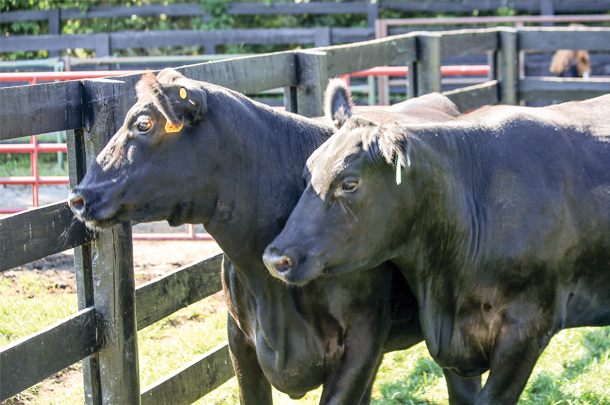
A sustainable beef focus is evident as cattlemen produce more protein using less of the earth’s resources. Says Phil: “For me, the definition of sustainability is to build an operation that can be here long enough that my grandkids can continue farming.”
“The business can be stressful, lots of hours and never knowing what the next year will bring,” P.J. echoes. “But I get to do what I love every day. You’ve got to have it in your blood. It has to mean more than making a living.” ![]()
Sherry Bunting is a freelance writer based in East Earl, Pennsylvania.
PHOTO 1: While the vast majority of the Trowbridge Angus stay in the Northeast, they’ve sold cattle in all 50 states. They own just shy of 100 acres, but the 260-cow seedstock Angus herd is divided into management groups on contiguous farms the family leases and manages for owners who spend the weekdays working in the city and come to these second homes on the weekends.
PHOTO 2: Three generations of the Trowbridge family: Phil and Annie (front row) with grandchildren Tucker, Daisy, Taylor and Lily; daughter Amy and husband, Mike (left); and son P.J. and wife, Miranda (right). While son P.J. is a partner in the operation, daughter Amy, a fertility nurse, also helps in her spare time with IVF work on the farm.
PHOTO 3: Standing with the sixth generation, Phil welcomed buyers to the farm for the female sale in September.
PHOTO 4: Bids came fast and furious for the first lot to sell after a hearty breakfast. She was the top sale of the day at $20,000.
PHOTO 5: The cattle at Trowbridge Farms are on grass 90 percent of the time. Even in the cold winters of upstate New York, they are out all the time. “We are big advocates of letting cattle be cattle,” says Phil Trowbridge.
PHOTOS 6 & 7: While genomics and carcass traits are important, Phil Trowbridge wants cows that are phenotypically balanced from end-to-end, starting from the ground up with their feet. Photos courtesy of Sherry Bunting.








